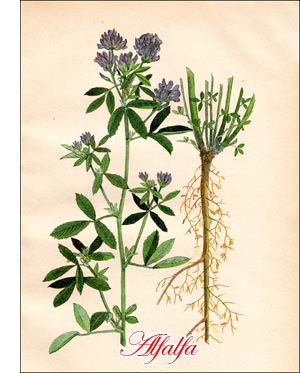Alfalfa seed

Seed:
At present Alfalfa is grown for seed to only a comparatively small extent in Canada. Its successful cultivation depends above all on the weather during flowering and ripening time. If moisture is abundant the plant will make a strong development of its vegetative organs and the seed will be insignificant and poor. The heaviest production is obtained when there is only enough moisture in the soil to allow the seed to mature fully.The plants also require plenty of light and room and for this reason a smaller amount of seed should be sown than for hay or pasture; ten to twelve pounds of good seed gives the best results. Any one of the season's crops can be used for seed, although there are several objections to the first cutting. The insects which fertilize the flowers are less numerous then than later, and the seed crop would therefore be rather light. The flowering of the first crop is comparatively uneven, and the quality of the seed is inferior.
Leaving the first crop for seed means a loss in hay, because after Alfalfa has produced seed the amount of hay or pasture that can be secured is rather small. For these reasons, it is advisable to cut the first crop for hay. Which of the subsequent crops should be used for seed will depend upon the length of the season and the weather. In Canada, the second crop will give the best results.
Alfalfa is ready to cut for seed when about half of the pods have turned brown and the seeds can be easily rubbed out. If allowed to develop too far, some of the earliest ripened and most valuable seeds will be lost by shattering.
Harvesting can be done as for Red Clover seed, the handling of the crop being as careful as possible to avoid shattering. For threshing, an ordinary threshing machine may be used, though a clover huller is better.
Quality of seed:
The seeds are kidney-shaped and yellowish brown, about twice as long as broad. In ordinary Alfalfa their surface is shiny; in the Turkestan variety, owing to a coat of waxy substance which can be easily rubbed off, the surface is dull. The standard weight is sixty pounds to a bushel.Impurities:
Alfalfa plants are very tender when young and are easily crowded out by weeds. Running the mowing machine over the field several times during the first season not only destroys the weeds but also strengthens the young Alfalfa plants. Although in old fields the plants are generally very vigorous, they are sometimes choked out in spots by aggressive weeds. To avoid this, the seed should be as clean as possible. The weed seeds most commonly found in commercial Alfalfa are Green Foxtail. Ribgras. Ragweed. Lamb's Quarters, Chicory, Yellow Foxtail and Smartweed. Noxious weed seeds less frequently found are Docks, Wild Mustard, Night-flowering Catchfly, Bladder Campion, False Flax and Canada Thistle.Diseases:
Alfalfa is less troubled with diseases than is Red Clover. It worst enemy is Dodder. Alfalfa Dodder, which is generally Cuscuta Epithymum Murr., is a yellowish parasite without leaves, consisting of a mass of fine threads from which are developed numerous roots called suckers. These suckers penetrate the Alfalfa stems where they absorb the food ready for the use of the host plant. The flowers are white and crowded into rounded clusters. Dodder appears at first in insignificant patches scattered throughout the field. These patches, however, steadily increase and after a few years a field may be so badly infested that the crop is ruined. The bust way to avoid this pest is to secure seed absolutely free from it. Should Dodder have established itself in a field, however, the infested plants should be immediately destroyed. Mowing will only remove the Dodder on the upper parts of the Alfalfa; it will not affect-that on or near the crown where it lives during the winter.This may explain its disastrous spreading. It is of course also possible that those parts which are not removed by cutting have a chance to set seed which makes new plants the next year. In which of these two ways Alfalfa Dodder is spreading in Canada is not yet known.